Physical Address
304 North Cardinal St.
Dorchester Center, MA 02124
![]() Access the accompanying videos for this chapter online. Available on ExpertConsult.com .
Access the accompanying videos for this chapter online. Available on ExpertConsult.com .
Both patent ductus arteriosus (PDA) and vascular rings often require surgical treatment. Persistent PDAs can lead to congestive heart failure, failure to thrive, and pulmonary hypertension as well as an increase in the risk for developing endocarditis. As such, intervention should be pursued when detected. Since surgical ligation of a PDA was first successfully performed by Gross in 1939, many large series have shown PDA ligation is safe and effective.
Abnormalities of the aortic arch that encircle or impinge on the esophagus or trachea can lead to dysphagia, or airway obstruction and respiratory distress. Division of the vascular structures compressing the trachea and/or esophagus is required to relieve the compression and provide symptomatic relief. With advanced thoracoscopic skills, both of these entities can now be approached successfully using a minimally invasive approach.
The workup for these lesions is fairly straightforward. For a PDA, an echocardiogram (ECHO) is usually all that is necessary. While most of these infants are initially treated medically or by observation, those with significant symptoms may warrant early ligation. In general, a preterm newborn over 1 kg is a possible candidate for a thoracoscopic approach, depending on the skill of the surgeon. Those under 1 kg are more difficult because of limited space, which limits the ability to place an endoscopic clip.
Vascular rings may be diagnosed by ECHO as well. However, many of these patients present with upper airway or swallowing issues. The initial diagnosis is often made by bronchoscopy or barium swallow showing airway or esophageal compression. However, the definitive diagnosis should be obtained by getting a computed tomography (CT) angiogram or a magnetic resonance imaging (MRI) scan to define the exact anatomy. There are a number of variations of vascular rings, but the three most common are a right arch with an aberrant right subclavian artery, a dominant right arch with an atretic left arch, and a true double arch. These patients tend to be larger when diagnosed and almost all are suitable for a thoracoscopic approach.
Prior to arriving in the operating room (OR), the patient should be typed and crossed for blood and it should be present in the OR. The patient is also given a preoperative dose of a first-generation cephalosporin. The position of the patient on the OR table for PDAs and vascular rings is similar. As these are posterior mediastinal structures, patients are placed in a modified right lateral decubitus position, more prone than supine. This allows gravity to help retract the lung medially, which eliminates the need for a lung retractor. Also, the patient is positioned near the right side of the table, not the center, so that the table does not interfere with the handles of the instruments. Also, this positioning puts the surgeon in a more ergonomic position. The surgeon and assistant are positioned at the baby’s front and the scrub nurse is positioned on the left (patient’s back side). The assistant is usually on the surgeon’s left. The main monitor is situated behind the patient’s left shoulder ( Fig. 39-1 ).
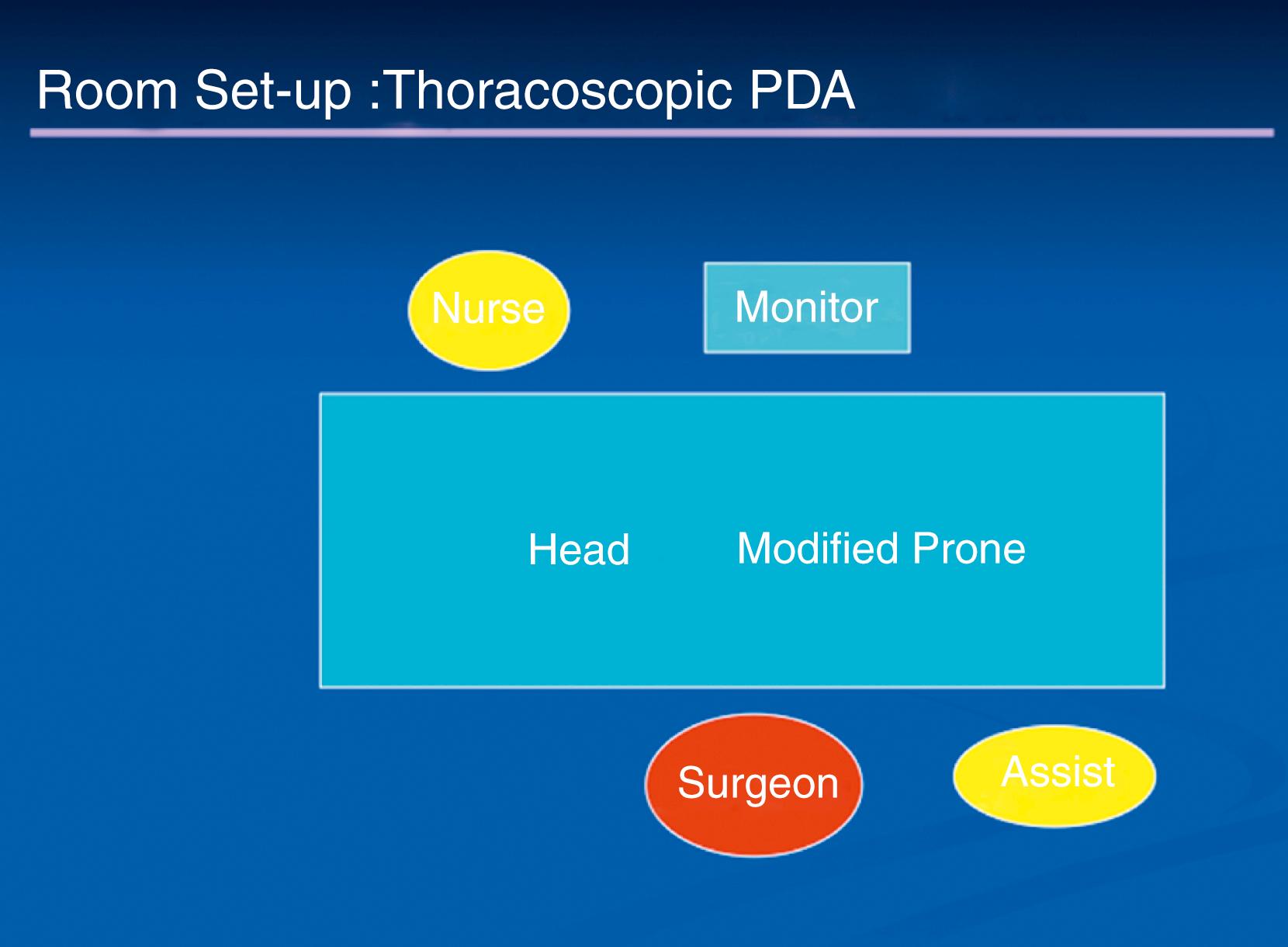
For most PDAs, a pressure of 4 to 6 mm Hg and a flow of 1 L/min are adequate to collapse the lung enough to allow visualization of the posterior mediastinum. In patients with a vascular ring, single-lung ventilation is preferable if it can be obtained, because the anatomy and the operation are more complex and a quiet lung field can facilitate the case. This is easily accomplished with a right mainstem bronchial intubation.
In most patients, there will be an initial period of oxygen desaturation, sometimes into the low 80s, when the chest is insufflated. This relative desaturation tends to be short lived as blood is shunted away from the collapsed lung. Therefore, the anesthesiologist should not overventilate during this period as it will reinflate the right lung, causing a loss of visualization.
For most PDAs, a single peripheral intravenous line through which blood can be infused is all that is necessary. But the anesthesia team may desire more invasive monitoring such as arterial or central venous lines. However, all patients should be monitored with pre- and postductal pulse oximetry. In cases of double arches, both the left arm and a distal extremity should be monitored.
Three ports are used, with a 4-mm port placed just posterior to the tip of the scapula for the telescope/camera. A 3-mm cannula is positioned anteriorly, approximately one to two interspaces above (in the axilla) the telescope/camera port, and a 3-mm port (which is later changed to a 5-mm port for clip or stapler application) is inserted posteriorly ( Fig. 39-2 ). A 4-mm 30-degree telescope and 3-mm instruments are used in most patients unless they are over 25 kg.

The initial step is the same in both procedures. The pleura overlying the aorta at approximately the level of the ductus is incised and extended longitudinally over the aorta for 1 to 2 cm. This point is often heralded by a crossing vein, which can be sealed and divided with the 3-mm vessel sealer or hook cautery ( Fig. 39-3 ). (In cases of vascular rings, greater exposure may be necessary.) The medial aspect of the pleura is then grasped with a Maryland dissector and a pleural flap is developed medially to expose the area of the ductus. This also helps to retract the lung medially and helps avoid injury to the vagus and recurrent laryngeal nerve (RLN).
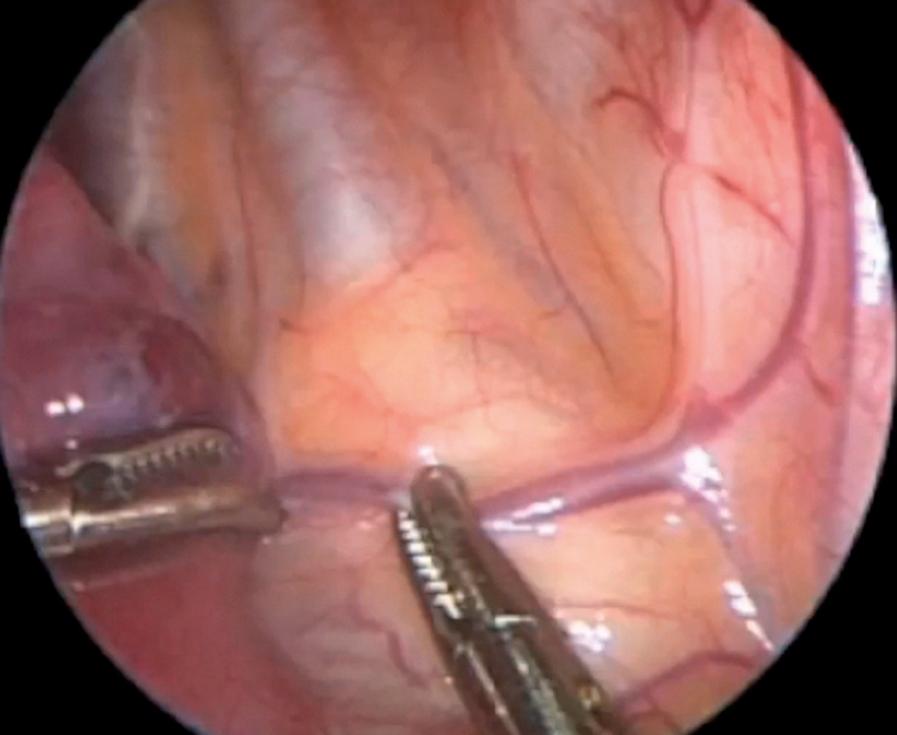
With the pleural flap mobilized, the ductus should now be visible. Dissection should start on the underside of the ductus at its juncture with the aorta ( Fig. 39-4 ). Using blunt dissection, a plane is developed behind the ductus. The RLN should be clearly seen coming around the PDA and care should be taken not to grasp or injure it. It also needs to be mobilized medially (pulmonary artery side) enough so that it does not get caught in the clip. Once a free plane is developed behind the PDA, the upper crotch should be dissected so a clear plane is seen between the upper border of the PDA and aorta. In most cases, it is not necessary to completely encircle the ductus as the clip will go anterior to posterior. Also, encircling the ductus can be difficult, especially in premature infants because of the angles. (However, in patients with a vascular ring, this step is necessary as the ductus or ligamentum needs to be divided.)
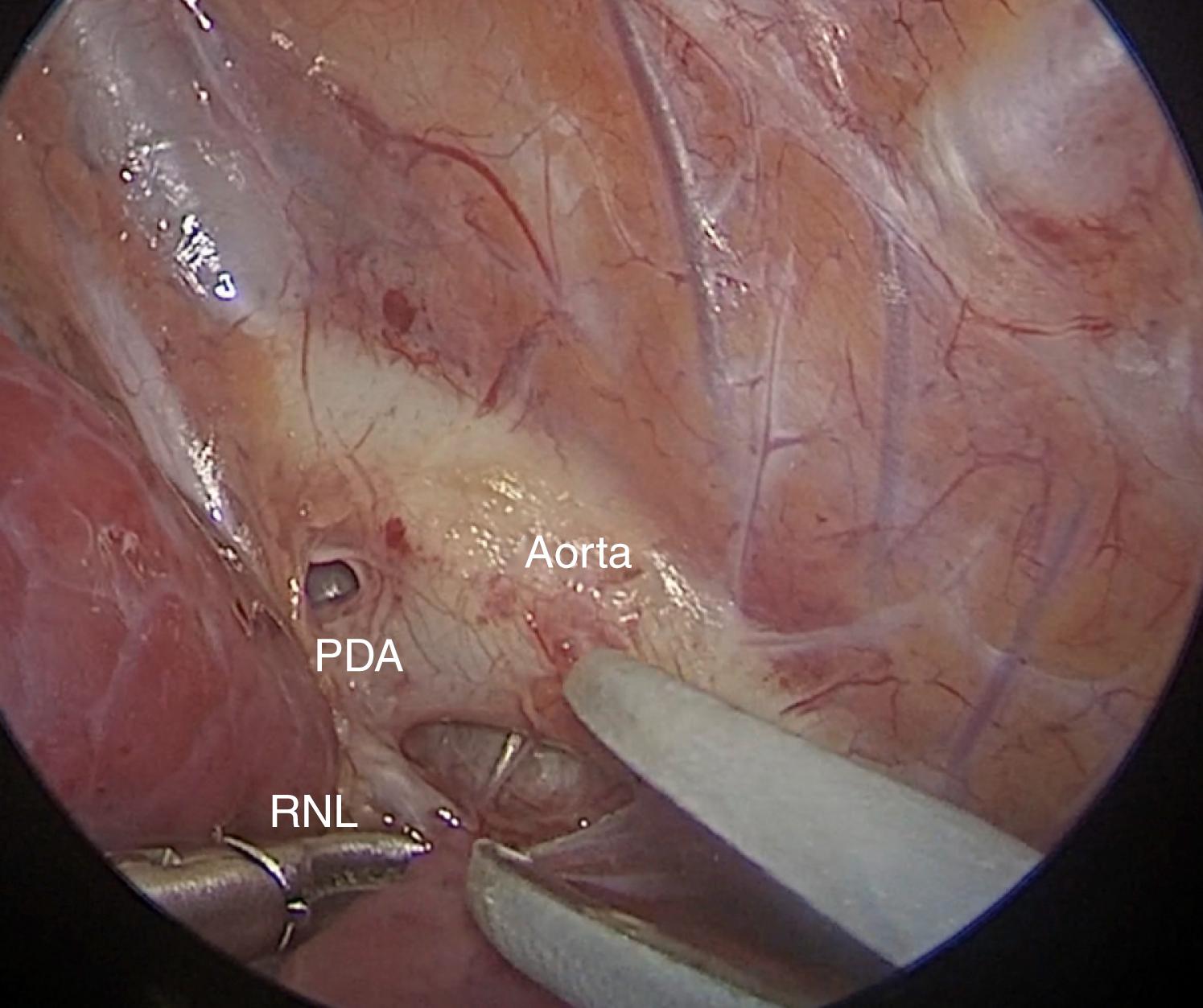
Once adequate mobilization is obtained, a test clamping is performed using a Maryland clamp and the distal pulse oximeter is monitored ( Fig. 39-5 ). If this remains unchanged, then a single 5-mm endoscopic clip is applied. At this time, the lower right-hand port (3 mm) is changed to a 5-mm radially expandable port. It is extremely important to prefire the clip applier outside the patient to make sure it fires properly and the clip doesn’t scissor. The clip applier is then inserted in the 5-mm cannula. The clip should be preloaded before inserting the clip applier on the PDA. If not, the clip may be dislodged or push the ductus away, causing an incomplete occlusion. A single clip is then applied with slow steady pressure ( Fig. 39-6 ). The clip applier is then removed and the CO 2 is discontinued. The upper ports are removed and the sites sutured closed. The lung is actively inflated by anesthesia with positive pressure, and the remaining CO 2 is expelled through the 5-mm port. Once the lung is inflated, this cannula is removed under positive pressure and an occlusive dressing applied. A chest tube is usually not necessary.
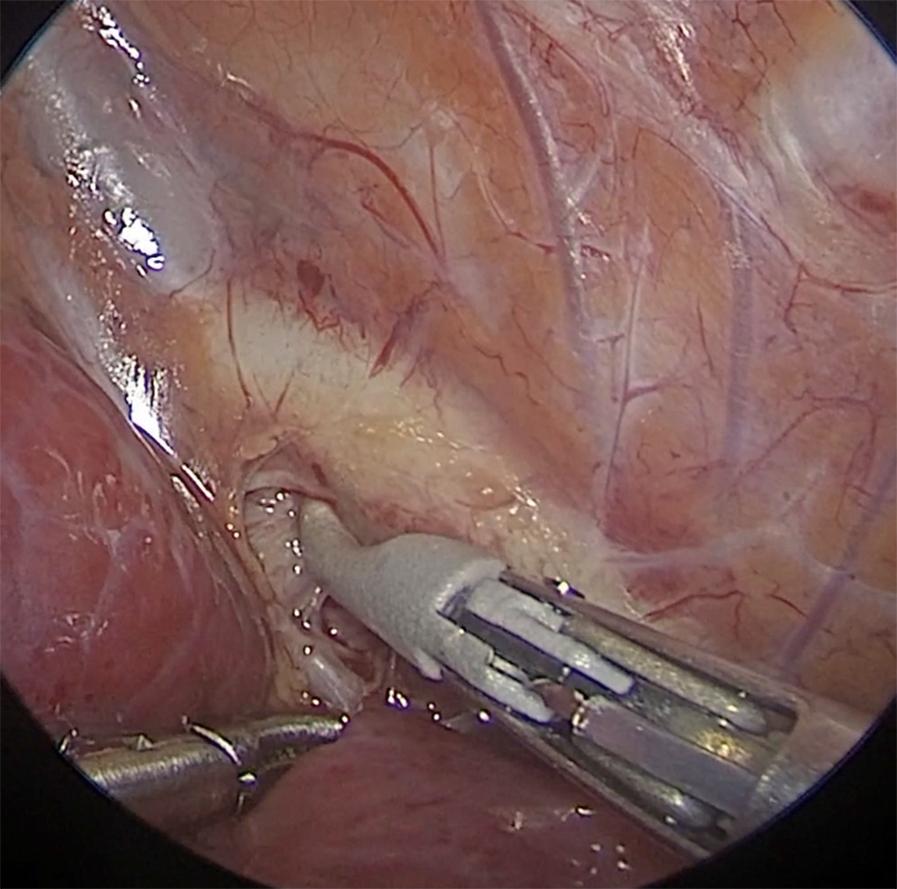
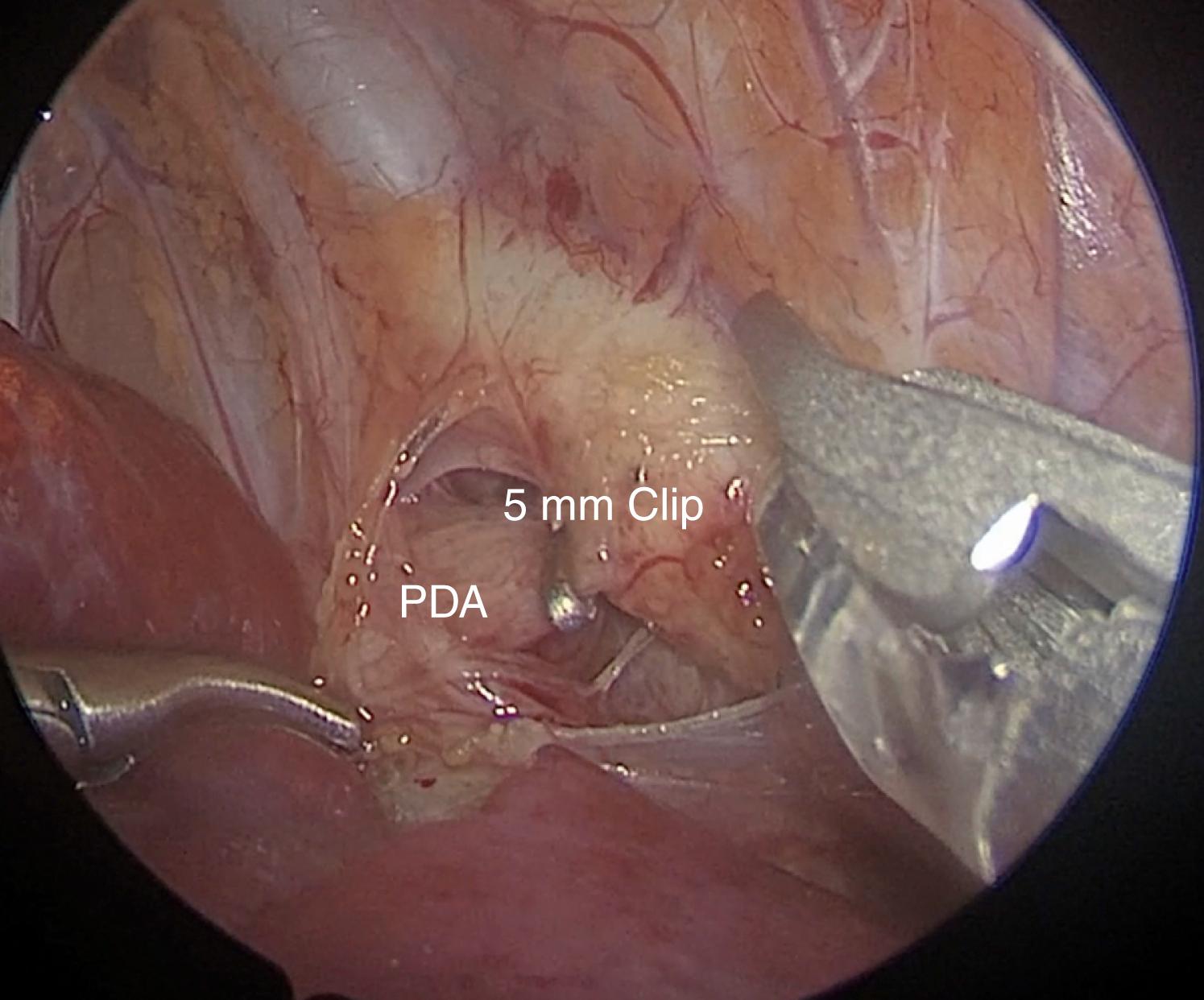
Become a Clinical Tree membership for Full access and enjoy Unlimited articles
If you are a member. Log in here